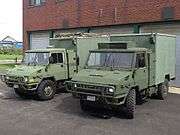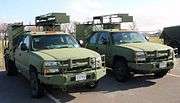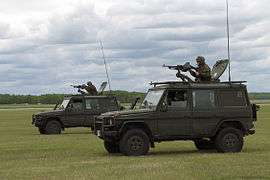33 Signal Regiment (Canada)
33 Signal Regiment, formerly known as 763 Communication Regiment, is a primary reserve Canadian Army unit of the Royal Canadian Corps of Signals (part of the Communications and Electronics Branch) in Ottawa, Ontario.

| 33 Signal Regiment | |
|---|---|
| Active | 2010–present |
| Country | Canada |
| Branch | Communications and Electronics Branch Primary Reserve |
| Size | 2 Squadrons |
| Part of | 33 Canadian Brigade Group |
| Garrison/HQ | Ottawa, Ontario |
| Motto(s) | TIGO API TIGO IMA, (Anishinaabemowin phrase meaning "Any time, any place") |
| Website | www |
| Commanders | |
| Commanding officer | LCol J Wopling |
| Regimental sergeant major | CWO J.A. MacKenzie, MMM, CD |
| Abbreviation | 33 Sig Regt |
Location
The unit is currently located at Major Edward James Gibson Holland VC Armoury at 2100 Walkley Road, Ottawa, Ontario.
History
33 Signal Regiment began on 12 October 1922 as the 3rd Battalion, Canadian Corps of Signals. It was redesignated as the 3rd Divisional Signals Regiment in 1926 and was divided into signal companies for the 1st and 2nd Canadian Divisions in the Second World War. Following the war it became the 3rd Signal Regiment until 1970 when it was allocated to Canadian Forces Communication Command (authorized on 1 April 1965) and redesignated as 703 Communication Regiment. Its mandate was to provide operationally trained communications personnel and to support the Regular Force in ongoing peacetime tasks and activities. On 1 June 1976 the unit was renamed 763 (Ottawa) Communication Regiment. The newly formed 76 Communication Group took command of 763 Communication Regiment from 70 Communication Group on 1 April 1977. The Regiment was housed at Wallis House Armoury in Ottawa and its support services were provided by CFB Ottawa. In the summer of 2010 it was renamed 33 Signal Regiment following its entrance into 33 Canadian Brigade Group (CBG).
33 Signal Regiment specializes in tactical and strategic communication, employing voice, electronic and telecommunication systems. Their mandate is to provide individual and collective support to Canadian Forces operations, both domestic and international. Many of their members have served in various UN and NATO peacekeeping missions around the world. This unit also provides communication support to the Army Reserve. Some units in the Communication Reserve also provide manning support to the Navy Transportable Tactical Command Centres.
Regimental badge
33 Signal Regiment Badge
On 15 June 2017, the new badge for 33 Signal Regiment was granted by the Governor General.
763 Communication Regiment Badge In July 1982, Her Majesty Queen Elizabeth approved a regimental badge having a right arm rising from three rivers; the Ottawa, Gatineau, and the Rideau, the definition used by the local indigenous inhabitants for identifying the locality. The trees acknowledge the importance of logging, the original commerce of the area. Combined, they reflect the traditional source of unit members as the Ottawa Valley. The arm holds a single reflex bow to show the operational environment. A double curve motif formed from a two-string wampum completes the design. In Algonquin legend, such a motif exuded power that could be oriented inwards, such as seen on women's and children's clothing to protect the wearer, or outwards as a way to transmit the bearer's power to others, not as electromagnetic energy (as we do today) but as an intangible such as information, providing the recipient with the power of knowledge. It also forms the figure "3", significant through the unit's history. String wampum was used by natives to pass messages, with the rarer purple beads being for the important parts, and the white beads for the rest. A such, it was a primitive version of encryption, and the reason that all messengers found with one were tortured: it was important. The motto, tigoapi, tigamoa, is Algonquin for "anyplace, anytime". The overall design is, from the Ottawa, secure communications for others, anywhere, anytime. The Algonquin had no word for "where": they used "place".
Training
Training is a year-round activity and soldiers are expected to attend up to two weekend training activities per month. Training is conducted at E.J.G. Holland VC Armoury and other locations. Once fully trained, soldiers can apply for various full-time and part-time employment opportunities available throughout the year.
Peacetime activity
The regiment is not without distinction, having won the Malloch Trophy, symbolic of the best signals unit in Canada, both pre and post-war more than any other unit in the history of the competition.
The regimental unit has served in most places the Canadian Forces are stationed across the nation and on deployed operations including Bosnia, East-Timor, the Middle East, Afghanistan, Kuwait & Latvia.
The regiment has a strong history of supporting domestic operations ranging from Operation Recuperation in 1998 (North American ice storm of 1998), to Operation Abacus in 1999 (Y2K), Operation Nanook (annual summer northern sovereignty operations),Operation Nunalivut (annual winter northern sovereignty operations), Operation Cadence in 2010 (support to the G8/G20 Leader's Summit), Operation Provision in 2016 (support of the 25,000 Syrian Refugees resettlement) & Operation Lentus in 2017 (support of record flooding in Eastern Ontario and western Quebec).
The regiment has also shown continued support to local community and charity events such as the Scott Tokessy Baseball Tournament, the Canadian Blood Services Blood Bank, the Ottawa Food Bank and, most notably for 25 years till 2016 providing communications links and a safety presence for the Canadian Ski Marathon.
Equipment
The Regiment operates a variety of vehicles, including:
- Light Support Vehicle Wheeled (LSVW)
 LSVW Command Posts
LSVW Command Posts- Command Post variant
- Cargo variant
- Cable laying variant
- Light Utility Vehicle Wheeled (LUVW) Militarized Commercial-Off-The-Shelf (MilCOTS)[1]
 LUVW MilCOTS - Line Laying variant
LUVW MilCOTS - Line Laying variant- Standard variant
- Cable laying variant
- Medium Support Vehicle System (MSVS) Militarized Commercial-Off-The-Shelf (MilCOTS)
 MSVS MilCOTS
MSVS MilCOTS- Cargo variant
- Flatbed variant
- G-Wagon
 G-Wagon
G-Wagon
Radio and Telephone equipment includes:
- Truck mounted VHF and HF Radio systems
- Man portable (MANPACK) VHF and HF Radio systems
- Static Radio systems
- Mobile Satellite Units (MSU)
- Satellite telephones
- Switchboards
- AN/PRC-138 [2]
IRIS family of radios [3]
Personal Weapons
- C7A2 5.56mm Rifle
- Browning 9mm Pistol
- C9 5.56mm Light Machine Gun
Honorary lieutenant-colonel
On March 24, 2010, Justin Fogarty was formally appointed honorary lieutenant-colonel of the 33 Signal Regiment. HLCol Fogarty is the managing partner of Regent Law Professional Corporation. HLCol Fogarty is now the Honorary Colonel of the Toronto Scottish Regiment.
Shortly following his appointment, HLCol Fogarty formed the Regimental Council of the Regiment, made up of 33 distinguished members from the business community to advise the Command Team at 33 Signal Regiment, promote the relationship between the business community and the Army, provide assistance on different initiatives important for the regiment and to assist in fund-raising initiatives for soldiers and their families.
References
- "Canadian Army". Army.forces.gc.ca. 2004-10-12. Archived from the original on 2012-12-16. Retrieved 2012-07-23.
- "AN/PRC-138 HF/SSB manpack (United States), Tactical communications". Retrieved 30 August 2012.
- "Iris communications system (Canada), Networks and integrated systems". Retrieved 30 August 2012.
- "Iris AN/PRC-521 Light Assault Radio (Canada), Tactical communications". Retrieved 30 August 2012.
- "Iris Combat Net Radio (Primary) (CNR (P)) family (Canada), Tactical communications". Retrieved 30 August 2012.